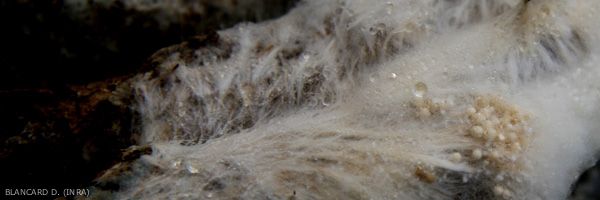
Athelia rolfsii
(Sclerotium rolfsii)
(Curzi) Tu & C. C. Kimbr., (1978)
Stem rot
- classification: Fungi, Basidiomycota, Agaricomycetes, Agaricomycetidae, Atheliales, Atheliaceae
- synonym: Sclerotium rolfsii Sacc., (1911)
- English names: Athelia stem rot, Southern stem blight
- Frequency and severity of disease incidence
This fungus causes severe losses particularly in the warmer regions of the world. Athelia rolfsii has a wide host range. It is rarely causes high losses on tobacco.
This fungus is present but has not been currently reported on tobacco in France.
- Symptoms
Wet looking lesions develop on the stems at the soil level (figure 1). They are often concave, light brown, rather dry in texture and sometimes surrounded by discrete concentric rings. Abundant white mycelium may cover the lesions and sometimes the soil close to the stem (figure 2 and 3). Numerous small (1-3 mm), smooth and rather spherical sclerotia of the fungus may be observed. At first the sclerotia are white, but gradually turn brown as they mature (figure 1 and 4).
- Biology
Athelia rolfsii survives in the soil on plant debris as aggregated mycelium and sclerotia. Periods of hot, humid weather favour its spread and development. The fungus grows well between 25 and 35 ° C. It can be spread by contaminated soil, water or infected plants produced in contaminated nurseries.
- Protection Methods
A number of methods recommended for control of Thanatephorus cucumeris or Sclerotinia sclerotiorum, both in nursery and field can be used, such as destruction of crop residues, soil disinfection, "solarization", and crop rotations.
U.S. situation
In southeast U.S. the disease rarely occurs. A few cases have been reported in Georgia and North Carolina. All cases were in fields with sandy type of soil where peanuts had been the previous crop. As a reminder this is a serious disease of peanuts in the southeast U.S.
Symptomatic plants look like been infected with Phytophthora nicotiana, the causal agent of black shank and can be confused with this disease. Close examination reveals that the root system of the infected plant is healthy and at the basis of the stem there is white mycelium. Occasionally also black structures called sclerotia can be found.
(Mina Mila - North Carolina State University)





